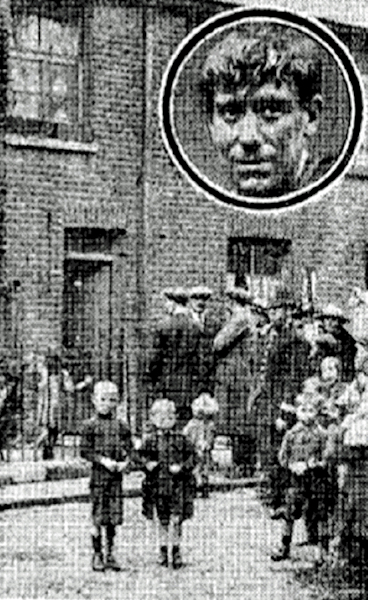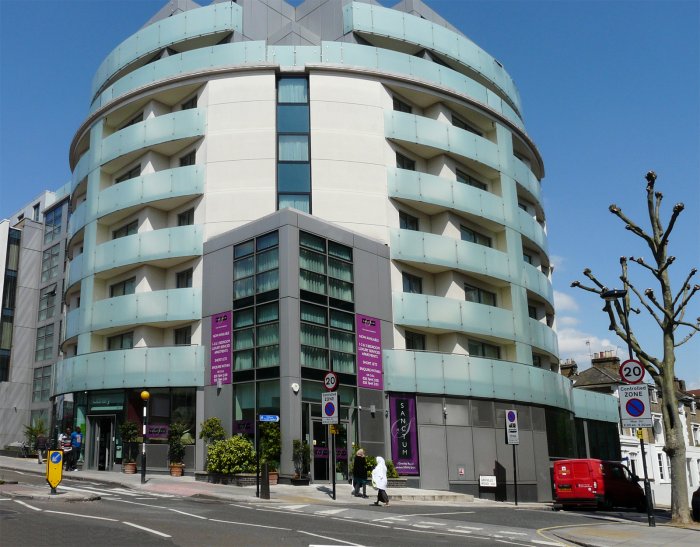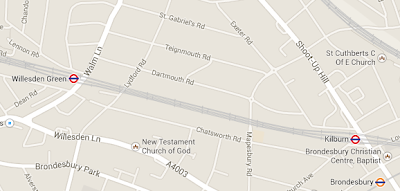Pembroke Place was a cul-de-sac of four-roomed houses off Granville Road in South Kilburn. It has long been demolished – today the St Augustine’s sports centre occupies roughly the same site. In the early 20th century, it was described as a mean and congested neighbourhood, where domestic violence often erupted. The properties were so small they were sometimes referred to as cottages and they were home to an endless succession of poor families. But even here, people were shocked by the skeleton under the floor.

Granville Road showing Pembroke Mews in Red 1890
In late July, 1919, Henry Hill – the tenant of No.12 Pembroke Place – became concerned about the foul smell in the house and found bones and a skull buried under the kitchen floor. The press immediately called the discovery ‘The Kilburn Mystery’. Initially it was believed there were two bodies and Sir Bernard Spilsbury, a pathologist who first came to public notice during the 1910 Crippen trial, was called in. Unfortunately the police removed some valuable evidence before Spilsbury arrived, but he soon identified the bones as those of a single young female.
Almost immediately, neighbours told the police they knew who it was. They believed the remains were those of sixteen-year-old Constance Grant, known to friends and family as Connie.
William John Grant and Alice Maud White, had occupied the house for just over a year before leaving that January. What unfolded over the next few weeks was a tragic story of neglect, poverty and cover-up.
William was born in London and worked as a labourer, but by 1919 he was employed as a boiler cleaner in a gas works. In 1888 he had married laundry worker Rosina Pyle. She died in 1907 and a year later William met widow Alice White. The couple decided to live together as common law partners. Between them the couple already had 12 children: William had eight and Alice four, and they went on to have another five children together. Their youngest was Doris. William and Alice were living in 12 Pembroke Place by Christmas 1917, sharing the small house with their own children and also Ada and Connie Grant, William’s daughters by his first wife. There were reports of quarrels, and some physical violence.
In January 1919, William and Alice separated. He moved in with a married daughter in Harlesden while Alice and the five children born to the couple, eventually ended up sharing two rooms with her daughter Ethel May (known as Maggie) at 16 Malvern Road, just a few minutes walk from Pembroke Place.
After the bones were found, an excited neighbour’s child ran round to Malvern Road and told Alice: “They are saying you murdered two children and buried them under the floor!” To which Alice replied, “They will have to prove that”. Alice promptly dressed herself and young Doris and went out with her friend Sara Harris. Sara said Alice intended to pawn a watch or neck chain for money, to pay for a meal that evening. Alice left Sara in the Harrow Road but didn’t return home.
The police were naturally very anxious to speak with Alice and circulated a description:
Alice White, also known by the names of Grant and Watts. 42 years old, around 5 foot 5 inches tall, dark complexion, dark eyes, full face, and medium build. Last seen with a black hat, wearing a long light-coloured overcoat and carrying a baby about two years old.
Clearly wanting to contribute something to the mystery, Sara Harris told reporters that on the day, Alice “seemed all of a flutter”. She also said Alice had told her she had found Connie dead.
With the exception of the absent Alice, everyone was questioned by the police as soon as the bones were found. The answer to when they last saw Connie varied from family member to family member. “I last saw her round about Christmas 1917 then she was gone”, said Alice’s son James. Alice told him Connie had run away. If that was the case, asked James, why not go to the police? Alice replied she’d already been and that, “Connie had been picked up and she will come back some day”.
Connie’s father William swore he didn’t know anything about her. He had last seen her sweeping the kitchen on 1 June, 1918. After that, Alice always made an excuse when he wanted to see his daughter, saying Connie was upstairs or at the local recreation ground with the other children. But the police were suspicious that William accepted his daughter’s absence so readily.
The latest sighting was reported by Maggie who said Connie was around the day her parents moved out of No.12, in January 1919. But with the different dates they couldn’t all be right.
The truth was that by the time the family left Pembroke Place, Connie had been missing for months. William’s elder son, Corporal Albert Grant, who was serving with the Air Force in France, told the police that when he was home on leave in January 1919, he went with his father to look for Connie at Pembroke Place. He said;
“We made a search of the house and found that all the furniture had been removed with the exception of a child’s cot. We noticed an unpleasant smell, but did not pay any particular attention to it. My father and I searched for Connie for some time but could obtain no news of her.”
They returned with a policeman but it was the next tenant of No.12 who discovered the bones. Henry Hill told the inquest that he had complained to the house agent about the persistent bad smell but eventually took matters into his own hands. He bought some carbolic acid and took up the floor boards by the kitchen fireplace. At first he and his son George thought they had found a rotten turnip but further excavation unearthed the skull, which “smelt most offensively”.

Pembroke Place and Henry Hill (circled)
Alice’s comment to her friend Sara, as well as her rapid exit from Kilburn, convinced the public that she had murdered Connie before making a run for it. Maggie was interviewed again and this time she said she wanted to tell the truth. As result of her new statement, she was arrested.
Maggie told the police that in October 1918, she had found Connie’s body in the coal cellar (actually a cupboard under the stairs). She was sitting upright and looked very thin. Maggie screamed and when her mother came to see what the matter was, Maggie ran away. Later she crept back into the house, looked in the cupboard and the body had gone. She never asked her mother what had happened to the corpse. The papers seized on this new twist:
“It is now practically certain that Constance Grant, whose remains were found under the floor of the back kitchen at No.12 Pembroke Place, was not murdered. It will probably be found that she died of self-imposed starvation, due to her mental condition.”
Connie had learning difficulties: one report of the inquest bluntly described her as “an imbecile”, while newspapers said she was “not very bright in intelligence, but good-natured and amiable”. Maggie swore that Alice thought the world of Connie. This was backed up by her brother James, who said Alice treated her own children and her step-children with equal affection.
The police redoubled their efforts to find Alice, and even planned to drag the Grand Junction Canal, as a woman and baby answering their description had been seen walking along its bank. Then a week after she had left Malvern Road, Alice calmly walked up to a policeman in Lewisham, saying she was wanted in connection with the Kilburn mystery.
Alice’s statement to police differed significantly from the information supplied by daughter Maggie and partner William Grant. The couple were arrested and appearing in court, where Alice stood in the dock with baby Doris in her arms. William sobbed as they were charged with manslaughter and illegally disposing of Connie’s body. Alice was hissed by the public when the skull was produced by the pathologist. Maggie was accused of taking part in illegally burying or disposing of Connie’s body, but this charge was later dismissed.

William Grant
The inquest and subsequent trial at the Old Bailey revealed the truth behind the family’s sad life. It wasn’t straightforward; family members contradicted each other, timings were inconsistent and most important, the medical evidence was inconclusive.
Connie was described as, “wearing glasses, short and thin, very dull and very dirty”. James said his stepfather William had hit Connie more than once for being slovenly. James remembered Connie’s foot being swollen and black around Christmas time, 1917. He thought she had chilblains, but her condition was more serious than that. One of her toes broke off as her father bathed her foot; William denied this and challenged James saying, “You are telling lies.” James saw Connie a couple of days later but then she disappeared.
Connie’s sister Ada Grant appeared in court to give evidence. She was malnourished and very small for her age. Chief Inspector Haig of Scotland Yard called her a “little mite”, and in court the jury was assured that despite appearances, she was actually 14-years-old.

Ada Grant
Ada said Connie did not go out to play and spent most of her time indoors, where they shared the top back bedroom. She’d last seen her when her foot was bad. After that, she never saw her again and when she asked Alice where she was, she was told Connie was in the front room which was always kept locked, with a curtain over the fanlight. Ada remembered Alice saying Connie was in bed the night before they left Pembroke Place. Alice was hissed again when she urged Ada, to speak the truth.
It was Alice who provided the most likely explanation of mystery. She said that after trying to bath Connie’s foot, it became inflamed and Connie couldn’t walk. So she slept in the living room for about a week. Alice said, “I gave her some cake. In the morning I went into the room and found Connie lying dead on the couch. I locked the door and let her lay there and I never told anyone.” Alice said this all happened not in December but March 1918. The reason she was so certain was because a few weeks later on 30 April, she said she gave birth to Doris. Alice said when she had recovered from the birth, she buried Connie’s body under the floorboards in the kitchen.
It is not clear how much William knew. He certainly lied about when he last saw his daughter alive, presumably to protect himself. Alice gave conflicting reasons for concealing Connie’s body: “I did not know what to do. William was a man she could not tell anything to.” But she also said, “I did this to save her father, as I did not want William to get into trouble”. She told her neighbour in Malvern Road that she didn’t want any reconciliation and had once threatened to take poison. But there was some evidence to indicate it wasn’t completely one-sided, that Alice could be a force to be reckoned with. William told a friend, “I am frightened to death. If I left her she would swear my life away.”
Given the condition of the bones, it proved impossible for Dr Spilsbury to establish exactly when poor Connie died. He concluded death occurred sometime between Christmas 1917 and March or April, 1918. The police claimed the bones had been buried as bones. Spilsbury said bluntly that “he could not form any idea as to the cause of death”. Connie might well have died from blood poisoning, given the condition of her foot.
The pathologist concluded that if the body had been placed in the manhole he had seen in the passage and covered with an air tight lid, “nine months would have been sufficient to have cleared the bones”. Perhaps Alice first placed Connie under the manhole, then later removed the bones and buried them. But she always maintained she had put Connie’s intact body under the boards: “The child was put down absolutely whole.” When asked to account for the absence of three ribs, Alice replied that the place was overrun by rats.
At the Old Bailey on 13 Sept 1919, William and Alice were found not guilty of manslaughter but guilty of wilful neglect and disposing of the body. The judge said he was “unable to draw any distinction between the prisoners as to the degree of their guilt.” Although he had encountered worse cases of neglect, he had “never heard of a worse case of thwarting the ends of justice by disposing of a body. This gave rise to grave suspicions which nobody could pretend were cleared away. They had disposed of the body to avoid an inquiry.”
William and Alice were both sentenced to 18 months in prison with hard labour. Four of their children were put in the Willesden workhouse before the trial was held. But we don’t know what happened to baby Doris.










































